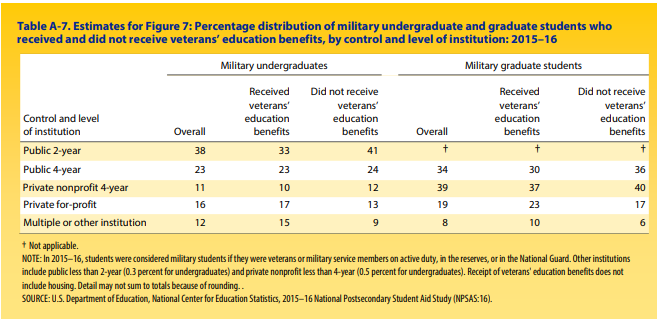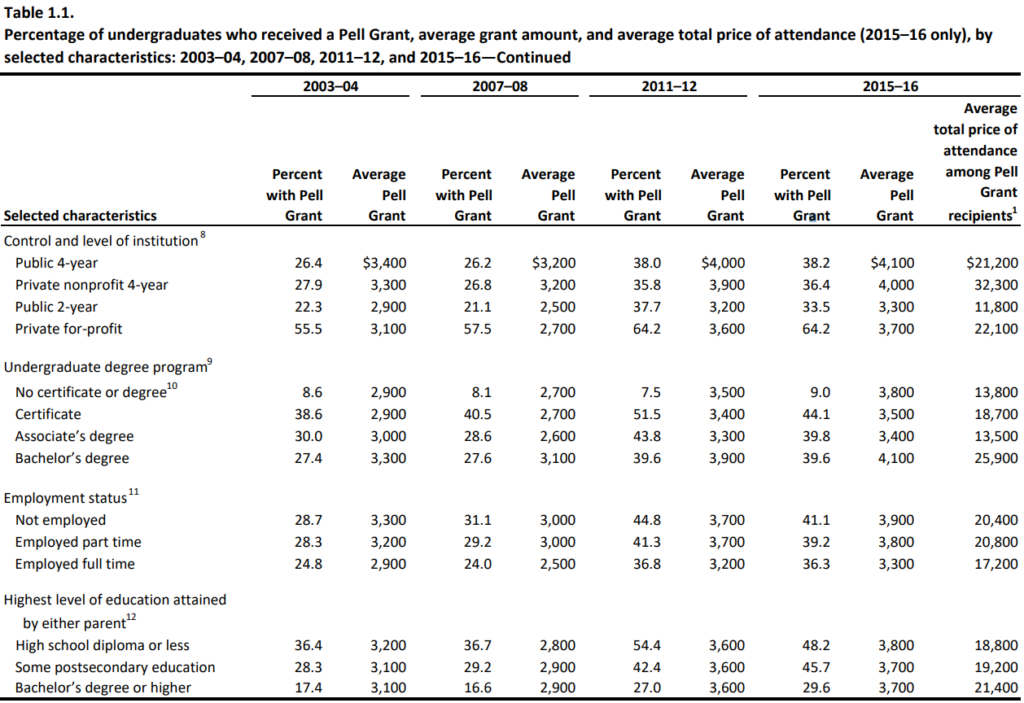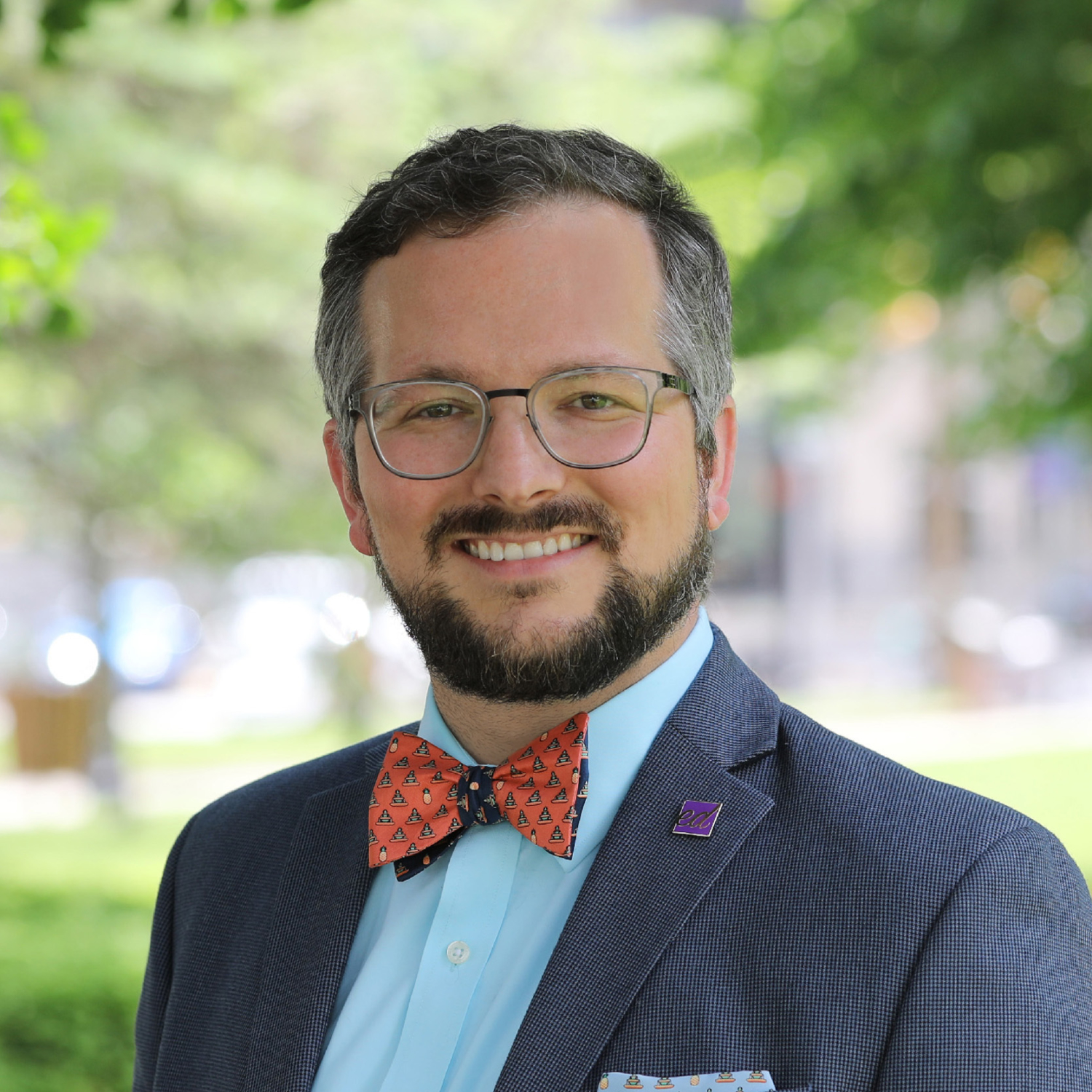Public Aid for Private Schools Already Happens
When I present on what education savings accounts (ESAs), vouchers and tax-credit scholarships are and how they work, I always try to start with one big request: Raise your hand if you know someone who has used a school choice program. There are usually no hands in the air at that point except my own. I follow that up by asking: Now, how many of you know someone who has received benefits through the GI Bill or a Pell Grant? Usually at least half of the people in the audience raise their hand.
The GI Bill and the Pell Grants Program are school voucher programs for adults. All over the country, students are allowed to use those federal taxpayer funds at both public and private institutions, and although I know this can happen, I wasn’t sure the extent to which it actually does happen. The National Center for Education Statistics’ (NCES) 2015–16 National Postsecondary Student Aid Study had some answers. Here’s the data on usage of the GI Bill, from a March 2020 NCES publication:

And here’s the data on Pell Grants, from a September 2019 NCES publication:

What this tells us is military undergraduate (10%) and graduate students (37%) use their education benefits through the GI Bill—a school voucher—to attend four-year private non-profit colleges and universities. And whatever you feel about for-profit schools, even more military undergrads (17%) and grad students (23%) used the program funds to attend private for-profit colleges and universities. Notably, 20 percent of private higher ed institutions are religiously affiliated.
In raw numbers, 783,269 veterans used the GI Bill to attend the school of their choice in FY2018.
Want more local proof? The U.S. Department of Veterans Affairs has a GI Bill Comparison Tool that lets you look up schools in a given city. I used the default settings and looked up schools able to attend in person in Indianapolis. On the first page, I noticed Butler University (a private liberal arts university) has 73 GI Bill students in attendance and Christian Theological Seminary (an ecumenical seminary related to the Christian Church) has five GI Bill students in attendance. I live within two miles of both of those campuses, which means that there are at least 78 GI Bill students within a fairly short walking distance of my house. If you were to do this in your area, you’d probably find you are closer to adults who use school vouchers than you thought. There are probably some in your family.
Don’t know anyone with military experience? Well, more than one-third (36%) of undergraduates at four-year private non-profit colleges and universities are doing so using their federal Pell Grant funds. Odds are that if you know three people who attended a private university then you know at least one that did so with a Pell Grant.
And there are other federally funded voucher programs for adults that are able to be used to help pay tuition at private higher ed institutions, like the Federal Supplemental Educational Opportunity Grant (FSEOG), the Teacher Education Assistance for College and Higher Education (TEACH) Grant, and the Iraq and Afghanistan Service Grant.
Why does any of this matter?
It means there are people using taxpayer funds through a voucher program to attend private schools in higher ed in every state in the U.S. right now. And people love it. The public has always supported it. We see it as a benefit that those who have served our country deserve. And veterans are generally satisfied with the program, which is responsible for the education of more than 67,000 doctors, 91,000 scientists, three Supreme Court justices, 14 Nobel Prize winners and, yes, 238,000 teachers.
Similar K–12 programs that allow families to send their kids to schools other than the traditional public school assigned to them, such as open enrollment, charter schools and voucher programs, can boast similar success data. The public are more likely to support them than oppose them. And the long-term attainment of students who use voucher programs to attend private schools is promising.
The GI Bill and the Pell Grant Program are school voucher programs that clearly foster human potential and ultimately lead to a stronger society. Yet K–12 programs that operate the same way—programs that help children access the right schools and services for their needs—are often met with vitriol. It doesn’t add up, and our children deserve the same common sense applied to their lives.
The only way to make that happen? Share the information and talk about it. I do it every day. And in time, perhaps I’ll see every hand in the room go up when I ask: Do you know someone who has used school choice?




